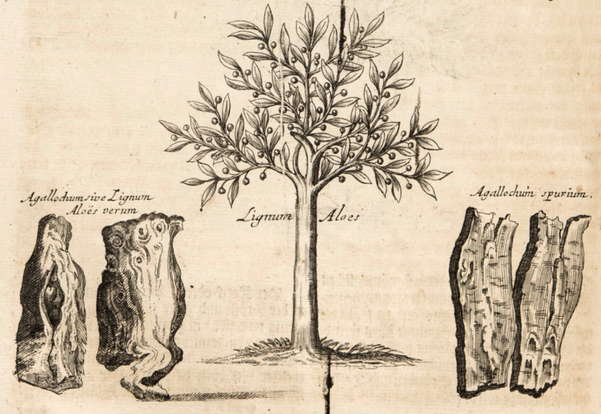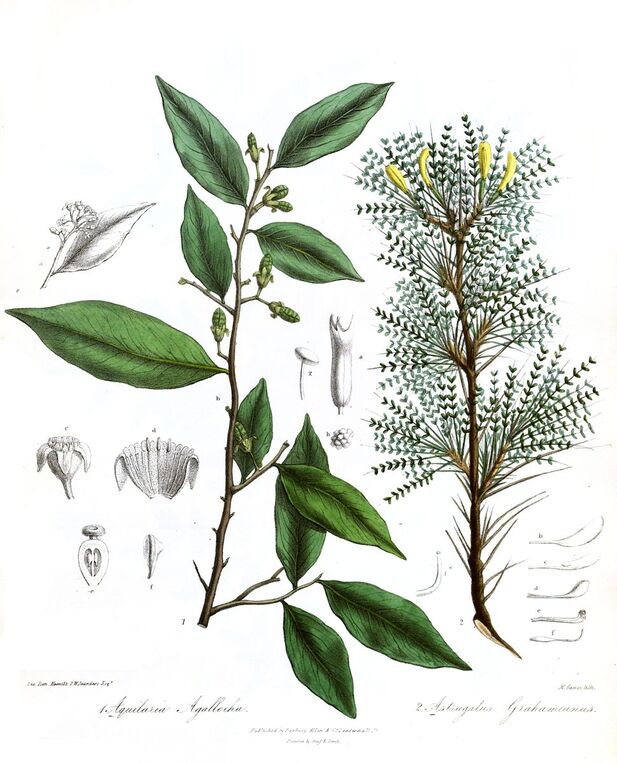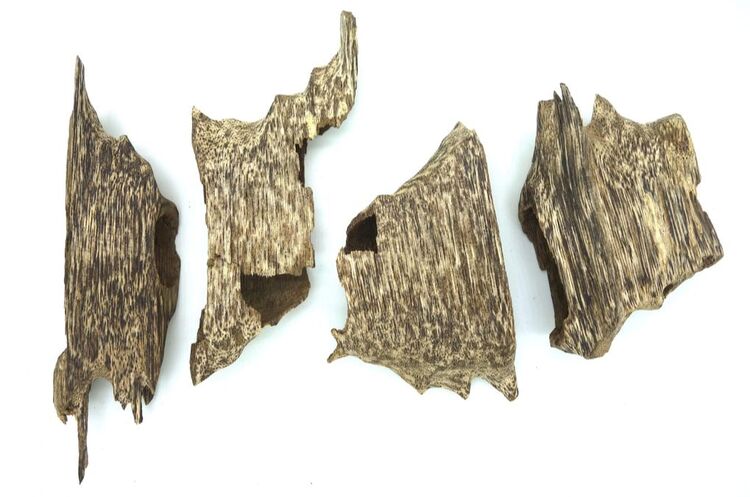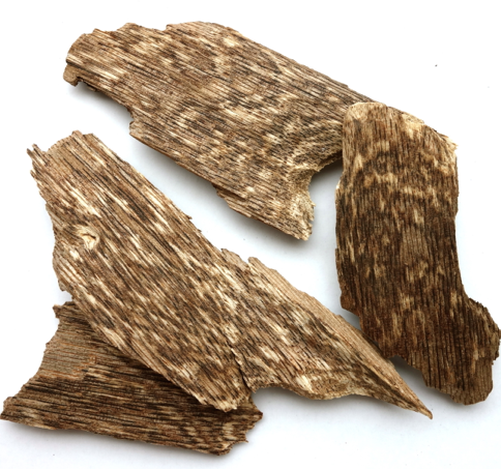Left: True Aloeswood; Center: Aloeswood tree; Right: 'Spurious' (false) Aloeswood
Museum Museorum, Valentini, 1704
Museum Museorum, Valentini, 1704
A. agallocha (left)
Royle, J.F., Illustrations of the botany and other branches of the natural
history of the Himalayan Mountains and of the flora of Cashmere, (1839)
Royle, J.F., Illustrations of the botany and other branches of the natural
history of the Himalayan Mountains and of the flora of Cashmere, (1839)
Two varieties of Aloeswood typically available on the modern market (Adam, 2015, 2019)
Botanical name:
Various species of Aquilaria:
Parts used:
Resinous wood
Temperature & Taste:
Warm, dry. Pungent, Bitter, Aromatic
Classification:
2B ATTENUATERS. 2H. CARMINATIVES. 2S. STRENGTHENING MEDICINES
3D. CORDIALS & CARDIACS. 3F. LITHONTRIPTIC
4a. CEPHALIC. 4c. CARDIAC. 4e. STOMACHIC. 4g. HEPATIC
Various species of Aquilaria:
- A. aqallocha is the standard product
- A. malaccensis
- A. sinensis
- A. crassna
- A. secundaria
- A. ovata
Parts used:
Resinous wood
Temperature & Taste:
Warm, dry. Pungent, Bitter, Aromatic
Classification:
2B ATTENUATERS. 2H. CARMINATIVES. 2S. STRENGTHENING MEDICINES
3D. CORDIALS & CARDIACS. 3F. LITHONTRIPTIC
4a. CEPHALIC. 4c. CARDIAC. 4e. STOMACHIC. 4g. HEPATIC
ADVERTISEMENT
Uses:
1. Regulates the Qi, Settles Wind, Calms the Mind:
-important medicine for all types of Qi and Wind disorders; it regulates Qi
-Hypertension, Dizziness, Vertigo
-Insanity, Nervous and Mental disorders as well as Melancholy (West, Tibetan Medicine)
–'It comforts the Brain and Animal Faculty’ (Salmon)
-'Strengthens the Senses'. (Avicenna)
-"It strengthens the nerves and is useful for them by its oiliness and tenuous viscosity". (Avicenna)
-'It clears the Mind and keeps one in good mental condition'. (Ben Cao Gang Mu)
2. Moves Qi, Strengthens the Heart:
–strengthens the Heart and makes it cheerful'. (Avicenna)
-‘Fortifies the Heart, cheers the Spirits'. (Salmon)
-Palpitations, Chest tightness
-Exhilarant (Unani)
-protects the Heart in Fevers.
-used when Wind enters the Heart (Tibetan Medicine)
3. Warms the Digestion, Moves the Qi, Eases Pain:
-distention or pain in the epigastric or abdominal area;
-vomiting, belching, hiccoughs from a Cold and weak stomach and spleen.
-abdominal pain due to internal bruising, stagnant Blood and Tumors
-‘A Great strengthener to the Stomach’ (Culpeper); some older TCM texts said it ‘Tonifies the Spleen‘.
4. Strengthens the Lungs and Kidneys, Stops Wheezing:
-Asthma and Wheezing from weakness especially if with Kidney weakness.
-tightness of the Chest, Emphysema and Pleurisy.
-Catarrh in the West; used for Rhinitis and Sinusitis (Ayurveda, Tibetan Medicine).
5. Guides the Qi down:
-special effect in guiding Qi down, and guiding Yang back to its base (lower body)
-it can warm and strengthen the Yang without allowing excess Yang Qi to move upwards to the head.
-good for Heat in the Upper body and Cold in the Lower body. (Li Shi Zhen)
-Rising Qi can cause Asthma, as well as Vomiting, Belching, and Hiccoughs.
6. Benefits Qi and Yang:
-Lethargy, Dullness
-warms and strengthens the Brain, Heart, Liver and Stomach (West, Unani)
-"Strengthens the Viscera and protects the organs from the flow of infiltrating malter towards them". (Avicenna)
-‘Strengthens the Brain and Whole Body’. (Schroder)
-‘It Strengthens the Whole Body and Restores in Consumptions’ (Salmon)
-‘Invigorates the 5 Viscera’, ‘Replenishes the Vital Essence’, and ‘Reinforces the Yang’ (Ben Cao Gang Mu)
-"It harmonizes the interior and tonifies the Five Viscera. It reinforces Jing". (Da Ming)
-considered Rasayana and strength-promoting in Ayurveda.
-traditionally used as an Aphrodisiac in the East.
Dose:
.. available in PRO version
Correctives:
.. available in PRO version
Substitute:
.. available in PRO version
Comment:
.. available in PRO version
.. available in PRO version
Correctives:
.. available in PRO version
Substitute:
.. available in PRO version
Comment:
.. available in PRO version
Main Combinations:
1. To strengthens the Heart and Brain, moves the Qi, opens the Orifices, and frees the Qi and Spirit from oppression, Aloeswood with ... available in PRO version
2. To strengthen the Heart, Stomach and Liver, and move Qi, Aloeswood with ... available in PRO version
3. Wind (Qi Stagnation) affecting the Heart (distention in the chest, poor concentration, dullness, insanity etc.):
i. Aloeswood, ... available in PRO version
ii. Aloeswood, ... available in PRO version
iii. Aloeswood with ... available in PRO version
4. Heart and Lung Fire with Palpitations and shortness of Breath, Aloeswood with ... available in PRO version
5. More severe Wind symptoms (including trembling, parkinsonism, numbness, paralysis) ... available in PRO version
6. Cold and Moist diseases of the Brain:
i. Aloeswood ... available in PRO version
ii. Aloeswood ... available in PRO version
7. Melancholy:
i. Aloeswood with ... available in PRO version
ii. Aloeswood with ... available in PRO version
8. Cold Stomach Pain, Aloeswood with ... available in PRO version
9. Abdominal distention and fullness, fullness and shortness of Breath, Aloeswood, ... available in PRO version
10. Hernia, Bloating, Aloeswood with ... available in PRO version
11. Retention of Urine and urinary difficulty from Cold, Damp and Qi stagnation, Aloeswood with ... available in PRO version
12. Phlegm-Heat attacking the Lungs with Cough, Wheezing, Bronchitis, Aloeswood, ... available in PRO version
12. Asthma, Aloeswood ... available in PRO version
Major Formulas:
Powder of Aloeswood (Mesue)
Aloeswood Powder for Palpitations
Troches of Aloeswood (Trochisci Aquilaria) (Mesue)
Electuary of Aloeswood (Diaxyloaloes) (Mesue)
Electuary of Aloeswood of Avicenna
Electuary of Aloeswood (Egyptian?)
Chen Xiang Hua Tan Wan
Chen Xiang Jiang Qi Wan
Aloeswood 8 (Tibetan Medicine)
Aloeswood 31 (Tibetan Medicine)
Aloeswood 35 (Tibetan Medicine)
Cautions:
1. In TCM texts it was forbidden to use it for Fire from Yin deficiency. However, with appropriate herbs, it can help lead the fire down while other herbs nourish Yin.
2. According to some Unani texts, long-term use can harm the vessels.
CITES listing
Several species of Aquilaria, notably A. malaccensis, are listed as endangered due to overharvesting. The illicit trade is huge and the global demand strong. It is used in incense and perfumery, as well as in medicine. Thankfully farmed material is available with a number of large farms producing a high grade product.
Main Preparations used:
Extract, compound Troches, and Compound Powder were commonly used
ADVERTISEMENT:
1. In TCM texts it was forbidden to use it for Fire from Yin deficiency. However, with appropriate herbs, it can help lead the fire down while other herbs nourish Yin.
2. According to some Unani texts, long-term use can harm the vessels.
CITES listing
Several species of Aquilaria, notably A. malaccensis, are listed as endangered due to overharvesting. The illicit trade is huge and the global demand strong. It is used in incense and perfumery, as well as in medicine. Thankfully farmed material is available with a number of large farms producing a high grade product.
Main Preparations used:
Extract, compound Troches, and Compound Powder were commonly used
ADVERTISEMENT:
Click the Tabs above for more information on this Medicine
|
'The use of this precious wood as a perfume and medicine is of great antiquity. Together with myrrh, cassia, and other products of the East, it is mentioned in the sacred writings of the Jews (Num. 24, 6; Psalm. 45, 8 ; Prop. 7,17; Cantic .4,14) under the name of Ahalotor Ahalim. It is the [?] of the ancient Greeks, which is described by Dioscorides as a wood brought from India and Arabia. Later writers, from Aetius' time, call it [?]; or "aloe wood," the name by which it is still known in Europe. The same substance is the Agaru of the Hindus, the Garu of the Malays, and the Chin-heang of the Chinese. In Sanskrit medical works it bears the synonyms of Raj arha "worthy of a prince," Visva-rupa "taking all forms," Krimi-ja "produced by worms," Krimi-jagdha, Anarya-ja "produced in a non-Aryan country," Kanaka "golden," Kaliya "black," &c, and is described as hot, light, and cholagogue; removing diseases of the ear, nose and eyes. In native practice Agar is used as a deobstruent, stimulant, carminative, and tonic; it is said to relieve the pain in gout, and to check vomiting. Susruta directs Aguru, Guggula, Sarjarasa, Vacha, white mustard, Nim leaves and salt to be made into a paste with ghee to form an anodyne fumigation for surgical wounds, called in Sanskrit VedanurakHhoghnairdhupaih. As aloe wood bears the Sanskrit name of Anarya-ja, it is probable that it was used by the aborigines of Eastern Asia before it became known to the Hindus, but that at a very early date it was carried overland to Central Asia and Persia, and from thence reached Arabia and Europe.
The early Arab travellers appear to have collected a good deal of information concerning the commerce and sources of supply of the wood. Yohanna-bin-Serapion mentions four kinds, Hindi, Mandali, Sinfi and Kamari, and Ibn Sina in the 10th century has the following account of it:—"The best is called Mandali from the more central parts of India; next is the Indian [or Hill aloe wood, which has the advantage over Mandali of preserving clothes from lice. Some say that Mandali and Indian aloe wood are the same. One of the best kinds is Samanduri from Sofala in India; again there is the Kamari and the Samfi from the same parts, and there is Kakuli, and Kismuri which is moist and sweet; and the worst kinds are Halai, Kamtai, Mabatai, Lancathi, or Rabatathi. Mandali is the best; then Samanddri, of a grey colour, fat and oily, heavy, without any white streaks, and which burns slowly. Some consider black aloe wood better than grey, and the best black is the Kamari, without white streaks, fat and oily, which burns slowly. In short, the best aloe wood is black, hard, and heavy, sinks in water, is not fibrous when powdered; that which does not sink is bad. The tree is said to be buried to promote the formation of aloe wood. The Arabian travellers give much the same names to different kinds of the wood. Ibn Batuta speaks of Kamari as soft, like wax. Abu Zaid calls it Kamariini, and says it is the best kind. Abulfeda states that it comes from the Kamarun Mountains. Kakuliis said to derive its name from Kakaleh in Java. The epithets Mawardi, Saimuri and Jawi are also applied by some writers to aloe wood. As regards the identification of these localities, we would remark that Samfi is probably derived from Champa, a province in Cambodia; Mandali, from Mount Mandar or Mandal, south of the modern town of Bhagalpur in Bengal; Kamari or Kamariini, from Kamarun, the Arab name for Cape Comorin; Saimuri, from Saimur or Samar, an island in the Eastern Archipelago; Halai may possibly be derived from the Hala Mountains between Sind and Beluchistan, as Abu Zaid says that the best aloe wood is brought for sale by Multanis. Haji Zein-el-Attar (1368) calls aloe wood Ood-el-juj, and in Persian, Ood and Balanjuj. After translating Ibn Sina's article on Ood, he gives his own opinion in the following terms : "The author of this work (Ikhtiarat-i-badiaa) says the best is called Kalambak, and comes from the port of Jena, which is ten days' |
sail from Java; it is sold for its weight in gold; you would think it odourless, but when warmed in the hand it has a very sweet persistent odour; when burnt, the odour is uniformly sweet until the wood is consumed. Next is Mandali and Samanduri, both from Sofala in India, the best of these is of a golden colour and heavy. Kakuli is like the Indian, and is generally in large pieces, marked with black and yellow lines; then there is Kamari, golden-brown, without white streaks, it comes from Kamarun and Sofala; then Samfi, from Samp, it is very hard and sweet; then Sakali and Afasi, a moist kind from China; then Mantai, Bandi, Halai, and Lanfi, all of about equal value. And in Manta there is a tribe who call the wood Ashbah, and it is of two kinds:one of these is in large pieces weighing from 5 to 50 maunds, without much odour, and used for making combs, knife handles, &c.
Mir Muhammad Husain (1770) writes:— "Ood, in Hindi Agar, is the wood of a tree which grows in the Jaintiya hills near Sylhet, a dependency of the Subah of Bengal, situated towards the north-east of Bengal Proper. The tree is also found in the islands to the south of Bengal, situated north of the Equator, and in the Chatian islands belonging to the town of Nawaka, near the boundaries of China. The tree is very large, the stem and branches generally crooked, the wood soft. From the wood are manufactured walking sticks, cups, and other vessels; it is liable to decay, and the diseased part then becomes infiltrated with an odoriferous secretion. In order to expedite this change it is often buried in wet ground. Parts which have undergone the change above mentioned become oily, heavy, and black. They are cut out and tested by being thrown into water; those which sink are called Gharki, those which partly sink Nim Gharki, or Samaleh-i-aala, and those which float Samalch; the last kind is much the most common. Gharki is of a black colour, and the other qualities dark and light- brown." The best kind for medicinal use is Gharki Ood from Sylhet; it should be bitter, odoriferous, oily and a little astringent; other kinds are considered inferior. In most receipts raw Ood (Ood-i-kham) is enjoined to be used to prevent the use of wood from which the oil has been abstracted by crushing and mace ration in water, or by crushing and admixture with almonds, which are afterwards expressed. This precaution is the more necessary as Ood shavings are an article of commerce in India under the name of Ghura agar; they are often adulterated with chips of Sandalwood, or Taggar, an odoriferous wood, common in India. Rumphius describes two kinds of true, and two of false, aloe wood; the first kind of true aloe wood, he says, is called Kilam or Ho-Kilam by the Chinese, and Calambac by the Malays, and is produced by a tree growing in the provinces of Champa and Coinam, and in Cochin-China. This tree has been described by Loureiro under the name of Aloexylon Agallochum. The second kind, called Garo, is the product of Aquilaria malaccemis, Lamk., which he figures. This is the Chin-heang of the Pun-tsaou-kang-muh or great Chinese Herbal. (See Hanbury Science Papers, p.263.) His two kinds of false aloe wood he attributes to Michelia Champaca and Exccecaria, Agallocha. Roxburgh and other botanists have examined the Aquilaria in Sylhet, and recently an Aquilaria has been ascertained to be the tree which produces aloe wood in the islands of the Mergui Archipelago. Gamble says that "Akyau (the Burmese name for aloe wood) is the most important produce of the forests of South Tenasserim and the Mergui Archipelago. It is found in fragments of various shapes and sizes in the center of the tree, and usually, if not always, where some former injury has been received." Aloe wood is used throughout the East as an incense and as a perfume, and was formerly used as a medicine in Europe for the same diseases for which it is still prescribed in India.' (Pharmacographia Indica, Dymock, 1893) |








